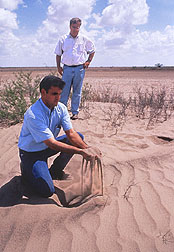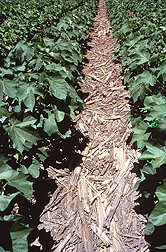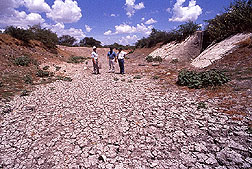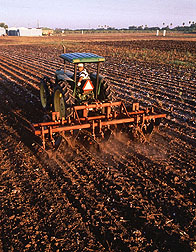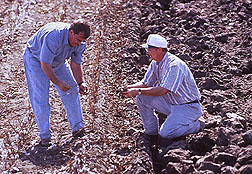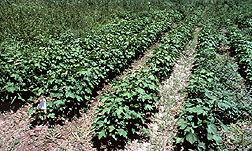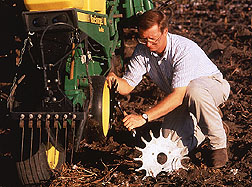Sustaining Agriculture in Drought Years
Punched by a 4-year drought and by insects that ravaged the cotton crop in 1995, Texas agriculture has been reeling. But new conservation tillage systems have taken out some of the sting. A team of scientists with the Agricultural Research Service in Weslaco, Texas, developed and tested the new systems.
They are the first designed for the soil and climate of south Texas, where growers plant more than a million acres of cotton, grain sorghum, corn, and other crops.
Keeping some of the previous crop's residue on the soil surface and reducing use of plows and other tillage equipment are central features of conservation tillage.
This approach makes soil, water, and other natural resources more sustainable over the long haul. Often, it allows growers to reduce costs—such as fuel and labor—while keeping yields acceptable.
Crop residue-based systems "have been accepted in the Midwest for 15 years," says soil scientist Joe Bradford. "But those systems won't work here. We have vastly different soils and climate, and growers here need solutions that take those differences into account."
For example, says agronomist James Smart, crop residue is harder to come by in south Texas. It decomposes much more rapidly in the semiarid, subtropical climate than in the humid Midwest. South Texas also lacks the Midwest's deep-freeze temperatures that hold down weed growth in winter.
"In Texas, weeds must be controlled year-round, and that has meant several tillage trips to plow them under," says Smart. He and Bradford are based in the Conservation and Production Systems Research Unit that is part of ARS' Subtropical Agricultural Research Laboratory at Weslaco.
|
|
No one knew drought was on the way in 1992. That's when Bradford, Smart, and agricultural engineer Robert Rektorik (now retired) began developing and testing new conservation tillage systems for dryland and irrigated farms in the Lower Rio Grande Valley of Texas. Earlier, ARS researchers in Bushland, Texas, pioneered conservation systems for dryland farms hundreds of miles north in the High Plains.
The Weslaco researchers found ways to maintain crop residue cover and control weeds with little or no tillage. Through field trials, they found that the new systems could increase net returns an average of $30 to $50 per acre for major crops like cotton, sorghum, and corn.
Results at some test plots are more dramatic, largely because drought is harshest on conventionally farmed crops. On dryland cotton plots at Mission, Texas, conservation tillage from 1993 through 1995 netted $35 per acre, compared to a loss of $32 on conventionally tilled plots. At irrigated Weslaco sites, conservation-tilled cotton netted an average of $82 per acre. Conventionally tilled plots lost $110.
The researchers also found strong economic benefits with irrigated and dryland sorghum and irrigated corn. They measured per-acre corn yields up to 130 bushels in conservation tillage plots. The area average is about 70 bushels.
"We have also noticed," Smart says, "that when we grow corn after cotton, this breaks the cycle of a cotton disease called root rot."
Similar systems, the researchers found, can work elsewhere in south Texas and in the part of the lower Rio Grande in northeastern Mexico.
|
|
Conservation Tillage Gets a Push From Nature
Drought has given new urgency to the Weslaco studies. Smart worries that "if farmers don't use conservation tillage, parts of south Texas and Mexico could become a dust bowl." He hopes its adoption will usher in an era of greater sustainability for the region's agriculture.
Texas normally ranks near the top nationwide in producing sorghum, citrus and vegetable crops, livestock, and cotton. But normal years have been rare since 1988, when crop-withering drought was soon followed by freezes that killed most citrus trees. The industry had to rebuild from the ground up, by planting new trees.
Cotton, sorghum, and corn make up about half the typical annual $400 million crop value in the lower Rio Grande in Texas. But drought and 1995's cotton crop failure triggered a dramatic turnabout in planting patterns.
In 1995, valley growers seeded 360,000 acres of cotton and 306,000 acres of sorghum. In 1996, cotton slid to 181,000 acres, while sorghum jumped to 504,000, partly due to higher prices resulting from a drought-related drop in grain sorghum and corn production in Mexico. But because drought also raises the threat of aflatoxin, a fungus-based grain contaminant, valley farmers in Texas planted only 20,000 acres of corn in 1996, down from 40,000 acres the previous year.
The valley's cotton and sorghum are planted in early spring and harvested in mid- to-late summer. Some growers replant these fields with corn that matures in December or January. With conventional farming, growers make between 7 and 16 trips over the fields.
|
|
Conservation tillage trades most of those trips for a soil blanket of leaves, stems, and stalks from previous crops. Less tillage means less soil compaction. Plus, the residue shields the soil from heat, wind, and rain. It keeps the soil cooler, cuts moisture loss from evaporation, and reduces labor and fuel costs, says Bradford.
Even before drought tightened its grip, valley growers had begun voting with their tractors: They now use conservation tillage on more than 100,000 acres, Smart says.
Results from the ARS experiments have been key factors in these grower decisions. Besides managing the test sites in Weslaco and Mission, the ARS researchers have been cooperating with the John Deere Co. and a Mexican growers' group on field trials in northeastern Mexico.
Drought Puts Conservation Tillage to the Test
As cotton and sorghum planting season arrived in the spring of 1996, south Texas reservoirs were near empty. Since fall of 1995, some areas had received only a few paltry inches of rain or none, instead of the normal 18 to 20 inches. Irrigation districts cut water allotments. Some towns restricted water for drinking and other uses.
In several irrigation districts, growers had to make do with one irrigation for the whole growing season. Many fields had been tilled several times to build, maintain, and weed raised seedbeds, and "farmers had disked the land to a fine powder," Smart says. To germinate their seeds, these farmers had to spend their sole water allotment right after planting. Rain would have to carry the crop to harvest. In many areas, rain wouldn't show up often enough.
But some farmers had "banked" water in the soil over winter. They had left the soil covered with residue and tilled it little or not at all. In spring, they planted cotton or sorghum on small, low ridges built with relatively light tillage equipment. Or they used no-till planters that placed seed directly through the residue. Either way, the soil held enough moisture from the preceding fall to germinate seeds and nourish tender seedlings. These farmers could save their irrigation allotment for early summer, when growing crops would most benefit.
Conservation tillage also benefits dryland fields, like those farmed by Wayne Labar and son-in-law Charles Wadkins. They began using conservation tillage about 4 years ago.
"Normally we get some good rain in February and May," Labar notes. But from mid-December 1995 until June 1996, his farmland got only 2 inches. "We didn't make a good crop. But we didn't lose money, because we didn't spend a lot. We only worked the soil two or three times."
By summer 1996, dust storms had become more common. Some fields looked like inland beaches, and adjacent fence lines and tree rows became sand dunes. Other fields resembled jigsaw puzzles made of broken, unglazed pottery. This was a result of rare but battering rains that sealed the soil surface, followed by heat that baked and cracked the mud.
Even without drought, Smart points out, valley growers using conventional systems have to replant at least some acres in most years.
"Rain shortly after planting can form a crust that seedlings can't penetrate," he says.
When Smart traveled to northeastern Mexico in August to check the tillage test sites, he was stunned. "The drought there is worse than in Texas—possibly the worst in a hundred years." He estimates several hundred thousand acres have been damaged in the states of Tamaulipas and Nuevo Leon.
Hector Rodriguez Mediola, one of the cooperators in the Mexico tests, grows irrigated sorghum with conservation tillage near Rio Bravo in Tamaulipas. In 1996 when irrigation water was limited, he harvested about 2,000 pounds per acre—not good, but something. Near the Rodriguez farm, conventionally tilled fields yielded only sand, gravel, and rock.
But "Rodriguez' land wasn't blowing at all," Smart says. "In fact, it gained topsoil." Crop residue had trapped some of the dust the wind had carried from other fields.
Ten of the 12 conservation-tilled sites in Mexico fared better than those farmed conventionally, though drought took a heavy toll—especially at the dryland sites. Still, irrigated sorghum at the Rio Bravo sites netted estimated per-acre returns of $157 with conservation tillage, which was 50 percent more than with conventional tillage.
In south Texas, harvested cotton and sorghum plants will generally resume growing throughout the relatively mild winter, robbing soil moisture needed for spring and summer. Plus, growing cotton plants can serve as wintertime boll weevil nurseries.
In Texas, a plowdown law requires growers to shred and destroy all standing residue after cotton harvest. The law was passed in 1987 after ARS entomologist K.R. Summy and other Weslaco researchers proved the hazard of letting the plants—and boll weevils—survive the winter.
Typically, farmers use a moldboard plow to kill both sorghum and cotton plants. But the stalk puller is a new conservation tillage tool for doing this in the lower Rio Grande Valley. Arrayed behind a tractor, stalk pullers resemble huge tweezers with disk-shaped tips. They pinch sorghum or cotton stalks at ground level and yank them out.
The stalk puller does this job for about $2 an acre and covers about 20 acres an hour. Using a moldboard costs six times more and takes about an hour to cover 3 to 5 acres. "It's a lot harder to drag a moldboard plow or heavy disk through the soil than to run a lighter piece of equipment over the top," Smart says.
The Weslaco researchers' conservation tillage systems also reduce use of heavy equipment by controlling weeds with herbicides.
"Every time you till or plow to control weeds, you're also planting more weed seeds--as well as making the soil more vulnerable to erosion, our most significant environmental contaminant," Smart says. "With conservation tillage a grower relies more on chemical weed killers because temperatures low enough to kill weeds seldom occur here during the winter. Several effective herbicides are available. They are generally low in toxicity to wildlife and beneficial insects, and they break down so quickly there's a minimum hazard to water quality."
|
|
Growers Run Their Own Field Tests
Concern over weeds has been one reason for Texas growers' skepticism about conservation tillage, popular in many areas of the nation for a decade or more. Says grower Wayne Labar, "We have not had confidence in the chemicals needed to replace tillage for weed control. But we've learned that they can do it."
Most valley growers probably took a similarly dim view of conservation tillage 5 years ago, says Smart.
"In 1992, when I spoke about conservation tillage at a half-dozen meetings, some farmers said switching would ruin them. They said, 'This isn't the Midwest. This is dry country. We have to plow to make a crop here.'"
"They were right in thinking that Midwestern systems would ruin them," says Smart. "Back then, they lacked some essential tools and practices, such as the stalk puller. But a few pioneering growers at first, and now more and more, are finding out for themselves that conservation tillage can work here."
"We argued against conservation tillage," says Charles Loop. He and his family grow mainly cotton and sorghum. The farm is about 1,200 irrigated acres near the banks of the Rio Grande near Brownsville, at the state's extreme southern tip. It's so far south, you can peer north into Mexico from some of Loop's fields, tongues of land formed by the river's twists and turns.
Until 1989, the Loops plowed deeply and tilled often, like nearly everyone else. Then, says Loop, "we got caught with a soybean crop that got hit with an early freeze. So we planted cotton and sorghum through the dead soybean plants." That was an experiment amid a crisis. It worked, and the Loops gradually switched almost entirely to conservation tillage.
|
|
"The earthworms were the first thing I noticed. We hadn't seen them before," says Loop. He thinks their passageways allow his cotton roots to dig deeper than in plowed soil. "We don't follow any set rules. But as long as yields are up and costs are less, we're going to stay with it."
Smart agrees there's no fixed recipe. "Each farm is different, and the first year is the toughest. The grower may need to reduce tillage operations gradually, rather than switch all at once. Residue is not built up yet, and soil organic matter takes several years to increase."
|
"An Experiment Continues" |
Further, growers need to understand why the new systems work--to make the most of them and avoid potential drawbacks.
For example, one drawback of surface residue is that it can tie up some of a crop's fertilizer if broadcast over the field. So Smart recommends using injector systems with liquid fertilizer. Pulled behind a tractor like a row of fat hypodermic needles, injectors squirt fertilizer just beneath the soil surface and near plant roots, with almost no waste.
Work to refine systems for cotton, sorghum, and corn will continue, say the researchers. And since the valley is an important producer of broccoli, peppers, and other vegetables, "we're going to be looking more at possibilities in those crops," Bradford says. -- By Jim De Quattro, ARS.
Joe M. Bradford is at the USDA-ARS Subtropical Agricultural Research Laboratory, 2413 E. Hwy. 83, Weslaco, TX; phone (956) 969-4859.







